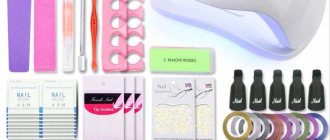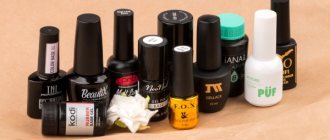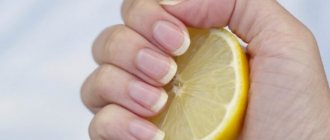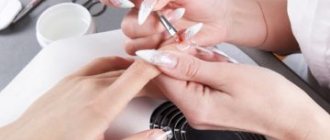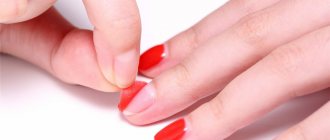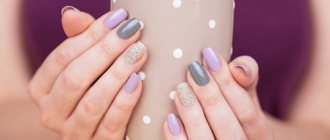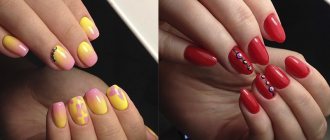What to do if a chip or detachment of the material is discovered
Chips and detachments are not always a problem for a master. The condition of the client's nails, internal pathological problems and diseases are also one of the factors that should be taken into account.
Let's look at the most common causes of chips and detachments of material, as well as how to work with them in most cases.
The first thing to do is to analyze the cause. These could be: problems with the lamp, with the coating, with the technician’s technique, the characteristics of the client’s nails, the client’s working conditions, when hands and nails are exposed to increased physical stress or exposure to a chemical environment.
Points for analyzing the causes of problems with coating durability:
- On which fingers and how often do chips occur if the client is a regular;
- How long after application of the coating does the problem appear?
- Perhaps the lamp has failed or the lamp model is old and cannot cope with modern nail coatings. The recommended replacement period for UV lamps is every 12-18 months with an average and large flow of clients;
- Sometimes it is enough to simply replace light bulbs or diodes whose resources have been exhausted;
- Insufficient lamp power to polymerize the coating; it is necessary to either replace the device or set a higher intensity, correlating with the polymerization time;
Every time a client comes to you for the next procedure, analyze in which areas and why there may be chips and detachments in order to select the right materials and technique for the new coating.
When a new client comes for a manicure, in addition to a visual examination of the condition of the hands and nails, it is worth asking him a number of questions. They will immediately eliminate possible problems with the wear of artificial turf. For example:
- What problems did you have with manicure and gel polish in the past?
- In what areas did chips and detachments appear?
- What type of activity does the client have?
If he works with household or other chemicals, or often comes into contact with water or dust, these factors must be taken into account.
List of 18 possible causes of chipping and peeling that manicurists encounter:
Reasons for gel polish peeling. How to extend the wear life of coatings?
Why does some people's gel polish last for 2 weeks or more, while others crack and come off after just a couple of days? Reasons for gel polish peeling? We will answer these pressing questions and tell you the secrets of the durability of gel polish on nails.
Why does gel polish peel off?
First of all, it depends on the manicure procedure itself. The following questions are especially important.
- Has the cuticle area been treated thoroughly? (Is the shine removed with a buff?)
- Has the first layer of gel polish been applied to the dried nail plate?
- Have you used a primer?
- Is the free edge of the nail sealed? (Sometimes the free edge of the nail is missing or the fingertips overlap the nail - this happens when the client bites his nails or cuts the free edge to zero).
Other reasons may be:
- constant contact with water - washing dishes without gloves, frequent hand washing, working in aggressive environments leads to the absorption of moisture by the nail plates, which causes detachment of gel polish or biogel;
- peculiarity of the nail plate (rejection of foreign material on the nails - this is when the work of several different masters and different materials does not last for the indicated 2-3 weeks);
- excessive moisture on the skin of the hands (for example, often sweaty palms) - in this case, it is advisable to go over the nail plate with a primer twice and dry it thoroughly before applying gel polish).
Physiological reasons cannot be excluded:
- diseases of the nervous system or a stressful period in life;
- disruption of the immune system;
- diabetes;
- taking antibiotics;
- rehabilitation period after surgery;
- pregnancy, hormonal imbalances and menstrual periods (in the first days you should refrain from extensions and applying gel polish).
How to make the coating durable?
Each manufacturer names different wear times, but it is usually recommended to renew your manicure once every 2 weeks. It also depends on the speed of nail growth: the client may come for the procedure a little more often or less often. How to ensure that the coating remains perfect throughout the entire wear period?
Let's look at the 2 most important rules that affect the durability of gel polish.
Proper manicure and preparation of the nail plate.
- Immediately before coating, it is not recommended to apply fat-containing preparations to the nail plate: cuticle oil, creams, lotions, removers with moisturizers. Be sure to use a nail degreasing agent before applying the coating. The liquid effectively disinfects the nail plate before working with various coatings (acrylic, gel, gel polish), and also delicately degreases and dehydrates nails without drying them out. For this you can use:
- Carefully remove the pterygium. With a wet manicure, it is easy to miss and leave it on the nail plate. Don't let this happen. You can effectively remove pterygium using:
– liquid for removing cuticles,
– professional tools for manicure and pedicure,
– devices for manicure and pedicure.
- Assess the condition of the nail plate. Has the previous coating been completely removed? If the top layer has absorbed a large amount of pigment, then between the upper scales there is now a small amount of varnish polymer. This factor prevents the gel polish from adhering to the nail. Buff your nails with a soft buff 240 grit. And also be sure to use a bonder for better adhesion of the material to the natural nail. For example, these:
- Note the split ends. Shorten your nails or remove any loose flakes. If the client does not want to remove the length, then the fragile ends need to be strengthened.
Correct application.
- The first thing you should pay attention to is applying the base. It should not get on the skin, but it should completely cover the area where the color will be. Otherwise, the gel polish may peel off.
- Second, always seal the ends of your nails. This applies to all coating layers, including primer and bonder.
- Third, be sure to strengthen your soft, springboard-shaped nails. Without strengthening, gel polish will not last long. Strengthening the nail plate can be done using single-phase gel or acrylic.
- There are often problems with the base “creeping” from the cuticle, side rollers and ends; this is due to the tendency of this polymer to shrink. To reduce this effect, you need to apply the base with a medium drop and dry one finger at a time in a good powerful lamp. For example, in this:
Having learned how to correctly diagnose the condition of a client’s nails and identify the causes of gel polish peeling, you will be able to do manicures at a whole new level. This will allow you to expand your base of regular customers who will come to you.
We wish you successful work!
Best regards, imkosmetik online store
Incorrect application of the first base layer
When leveling the nail plate with a base, we apply it in two layers. The first one must be well distributed using “trampling” or “driving” movements with a brush, so that there are no air bubbles under it, and the adhesion of the material to the nail scales occurs evenly, tightly, along the entire perimeter of the plate.
To distribute and “trample” the base well, it is better to use a flat, medium oval brush. You can use it with less material than a regular one and distribute it well.
It is important to cure this first thin layer well in the lamp, as it serves as the basis for future leveling, ensuring adhesion.
Working with the base coat: preparing the nail, applying a base for leveling
Strengthening nails with gel polish. What and how to strengthen your nails before applying gel polish?
Strengthening your nails before applying gel polish makes them stronger and less flexible, which increases the durability of the gel polish. This procedure is especially relevant for girls with thin, weakened nails, on which gel polish lasts less than a week.
Strengthening with acrylic powder
This method is even suitable for repeating on your own at home. This way you will create a strong frame by “concreting” the gel polish.
- 1
Prepare your nails for applying gel polish, sand, degrease, and apply primer.© Makeup.ru
- 2
Cover your nails with one layer of base and dry in a lamp. - 3
Apply a second coat of base and cover the entire nail with clear acrylic powder before drying it in the lamp. - 5
Lightly sand the surface and reapply the base layer, dry it in a lamp.
Strengthening with gel
The procedure is more complex, as it involves several variations of both the gel itself and the methods of applying it. The easiest way is to use single-phase silicone gel.
- 1
Prepare your nails for applying gel polish, sand, degrease, and apply primer. - 2
Apply two thin layers of gel to the nail plate and dry them alternately in a lamp.
Both methods of external nail strengthening allow you to remove the coating by soaking it at home. However, you can wear the coating longer if you correct it in a timely manner.
- 1
File off the top layer and especially the border of the regrown material at the cuticle. - 2
Carry out all stages of strengthening with acrylic powder or gel, filling only the free part of the nail.
Incorrectly selected base
How to choose the right base? It is necessary to take into account the shape and length of the client's nails. For example, the square shape of nails involves a much greater load than oval or others with rounded edges. This means that a square base requires a more rigid base with a reinforcing effect, applied taking into account the need to strengthen the growth points and the side ends of the free edge.
Base coatings: types, selection criteria, review of the best
The client's type of activity is not taken into account
The factor of the peculiarities of the load on the client’s nails in his field of activity is very important for analysis by the master when choosing materials for coating. If the client's hands often come into contact with chemicals, detergents or water, this creates additional stress and shortens the wear life of the material.
It is recommended to use a rubber plastic base or biogel for color coating. It is more flexible and durable, providing nail protection.
Biogel and its properties for strengthening, building, health and growth of nails
Detachment of gel polish caused by body characteristics
Each person is unique, just like his nails, and accordingly, the coating can be applied in different ways. In this case, choosing the right means is only possible through experimentation. The problem may be as follows:
- Hands and nails are too wet. Often there is a problem of hydration, which is solved by a more “powerful” primer or by applying a base twice. For reliability, this product is also applied to the ends of the nails.
- Fragility of nails, which shortens the wear period of the coating. For example, if the nail plate is not strong enough, the tips constantly break. It also happens that a girl independently decides to cut or file her nails, violating the integrity of the coating.
- The nails are very soft. In this case, the gel polish is quite difficult to apply, so a strengthening procedure must first be carried out.
- The presence of stripes, grooves, tubercles and other deformations that disrupt the surface of the nail. In this case, the coating can really peel off quickly if you do not use special products for gel polish.
- There are internal diseases of the body that reduce the wear time of gel polish. These are: diseases of the nervous system, hormonal imbalances and disorders of the immune system, previous surgery, taking antibiotics, diabetes mellitus. If the reasons described above are excluded, it is necessary to take into account the possibility of a problem with the body.
In addition to using various manicure products described above to eliminate the problem, it is recommended to get rid of the root cause. Today there are many folk remedies and pharmacy complexes that can cure soft or brittle legs.
Poorly performed manicure
Here we include the incompletely removed pterygium. What it is? The pterygium is the lower part of the cuticle that adheres to the nail and grows with it. These are whitish particles of dry skin along the perimeter of the nail plate. They are found not only in the cuticle area, but also in the proximal folds and along the lateral ridges.
Therefore, it is important to remove pterygium not only in the lower part, where the cuticle is located, but also along the entire perimeter of the nail, along the side walls. Then the base and gel polish will lie smoothly, tightly, and will not cause peeling.
Nail structure and growth: what healthy nails and skin should look like, care rules
Errors in manicure technology
Before applying gel polish, you must carefully treat the nail plate
- Poor quality treatment of the nail plate . When processing a natural nail plate, it is important to remove the shiny top layer using a nail file or buff. And a common mistake is insufficiently careful treatment of the nail plate at the cuticle itself. For easy access to all parts of the nail, it is better to use the corner of the buff; it is capable of treating hard-to-reach places where a nail file cannot reach.
- Manicure errors . Peeling of the gel polish can be caused by a thin film remaining on the nail along the entire cuticle line - pterygium. To avoid this, you need to do a hardware manicure or carefully treat the cuticle area of the nail with a pusher.
- Oily mark on nails . Gel polish can peel off if a person, after treating the nail plate with a buff, touches the nails with their fingers, which leaves greasy marks on the nails. This problem can be solved by degreasing the surface of the nail, and you need to remember that touching the nails while working is unacceptable.
- A wet primer can also cause your manicure to peel off. Apply the primer in a thin layer, in this case it dries quickly.
- A wet nail plate always leads to peeling of the gel polish, in which case the coating comes off the nail entirely like a film. Do not steam your nails before the procedure. If you have doubts about the moisture content of your nail, use a dehydrator.
- Gel polish should not get on the cuticle . If this happens, the gel polish must be removed from the skin before drying in the lamp. Try to step back half a millimeter from the cuticle, otherwise this will lead to peeling of the gel at the base of the nail.
- Leaving the free edge of the nail unsealed . Or another mistake typical of unskilled craftsmen is filing down the sealed edge. The same situation can occur when designing a nail tip that is too thick. Uneven load on the nail promotes peeling. If this is the case, then the only solution to the problem is to file away the excess material to lighten the load on the nail.
- Sometimes there is separation of one layer of gel from another , for example, color from the base. To avoid this mistake, use coatings without a sticky layer for the base and gel polish and with a sticky layer for the top coat. Tops without a sticky layer are prone to cracking.
Manicure on a wet nail plate is one of the common causes of gel polish peeling off.
When applying gel polish, do not forget to seal the free edge of the nail
You can find even more professional secrets that will help you avoid gel polish peeling in the video:
Each layer of gel nail coating should be thoroughly dried in a lamp. Therefore, it is necessary to ensure that the lamp is working properly and at full power. Change lamps on time to ensure they work. Use lamps of sufficient power, otherwise you risk not drying the gel enough, which will doom your manicure to peeling off.
Sawing nail plate
When working with cutters or files when removing material and filing the free edge, you can easily damage the natural nail plate. When applying a new coating in the cut area, there will not be the necessary tight adhesion, and as a result, the client receives detachments.
Hardware manicure - answering frequently asked questions
Life hack for beginners: use a beige or milky camouflage base for gel polish. Thus, when removing, the border between the artificial material and the natural nail will be visible, and cuts will be avoided.
The client tore off the gel polish from the nail himself
Then the peeled edge simply breaks off, which along with it pulls another part of the coating, or even material from the entire nail. As a result, we get damage to the nail plate not only in the upper, but also in the deeper layers, which can be equated to the same cuts. Such damage needs to be dealt with differently, ensuring preliminary leveling under the coating.
Why gel polish doesn’t stay on nails due to the master’s fault
Gel polish on nails most often does not stay on due to the fault of the master, although the process of performing a manicure does not present any particular difficulties, and the main reasons for the decorative coating coming off are the following violations of the technological process:
- there are remnants of microparticles of fat on the nail plate and adjacent areas;
- The base varnish is applied in too thick a layer, or its polymerization has not been fully completed (insufficient drying in the lamp);
- the free base of the nail was not sealed;
- poor quality preparation – the pterygium layer has not been removed from the plate near the cuticle;
- one of the layers (or all at once) is not dried well enough;
- The topmost layer of fixative (top) is not applied to the entire surface of the nail or lies unevenly.
Another common mistake of the master is that he uses varnishes from different ones due to different composition. Professionals recommend using base, primer, gel polish and top coat of the same brand.
Why do nails streak?
Gel polish can streak the nails and lie unevenly on the plate, and there are several reasons for this:
- the decorative coating has expired;
- loss of textural uniformity of gel polish;
- unevenness of the nail plate;
- not removing the sticky layer from the base.
It should be taken into account that any unevenness on the surface of the nail (grooves, roughness, tubercles) will be clearly visible even after applying gel polish - the coating completely repeats the relief of the plate, which leads to the appearance of stripes and uneven painting.
There are several options to solve the problem:
- It is worth preparing an ideal base for a colored coating, and this can be done using rubber material;
- before applying gel polish, gently roll the bottle with it in your palms - perhaps the pigment has simply settled, and shaking will solve the problem;
- remove the sticky layer from the base and dry the treated surface well;
- Apply both the decorative coating and the base in the thinnest possible layers and make 2 of them, thoroughly drying each in a lamp;
- apply gel polish with a drop, and then stretch it parallel to the nail (this is how you need to hold the brush).
Why did it become soft
Gel polish becomes soft even if the master fully complies with the technological process, and the reasons for this problem may be:
- weak/poor quality lamp - you should try to dry each layer of coating longer and carefully monitor the level of polymerization or change the bulbs/spirals/diodes to new ones;
- unsuitable lamp for gel polish - some brands produce coatings designed for drying only in “their” lamps;
- gel polish was applied, which is dried only in LED lamps, and the master uses a different type of lighting equipment.
The most common reason for the softness of a decorative coating is the expiration date of the material, but often there is a defect from the manufacturer.
Why does it flake?
Gel polish can begin to flake off literally in the first day after a manicure, and this problem is considered the most common, and its causes can be classic violations on the part of both the master and the girl/woman:
- the pterygium (a thin layer of skin on the nail near the cuticle) was poorly removed;
- the nail and the entire area around it were poorly degreased;
- the base, gel polish and top coat were applied in too thick layers and, as a result, did not fully polymerize;
- the top coat is applied unevenly;
- immediately after the manicure, the nails are in water;
- when working with any aggressive liquids, the girl/woman does not use gloves;
- manicure was applied during menstruation, pregnancy or in the acute phase of hormonal disorders.
To prevent gel polish from peeling off, you should remember three “don’ts”:
- the day before you cannot perform spa treatments or do oil manicures;
- in the first 10 hours, you should avoid prolonged dishwashing, hand washing and general cleaning;
- Using detergents, cleaners and any other aggressive liquids without gloves can cause the decorative coating to peel off.
Why does acrygel come off from nails?
Acrigel may come off from nails for the following reasons:
- during the preparation of the natural plate, the master cleaned the pterygium poorly;
- Initially, the cuticle was removed using a softener, and its particles remained on the nail;
- acrygel is placed too close to the cuticle and lateral skin ridges;
- the material is too liquid or too dry;
- Old ultraviolet lamps are used to dry the coating, but they do not polymerize the coating properly.
Also, acrygel can come off the nails if it is applied to a plate that is too long - the pressure on the tips of the nails increases, and the decorative layer begins to “spring.” In this case, the detachment of the material begins from the sides or directly at the cuticle itself.
Remover residues in the cuticle area
When using a remover to remove cuticles and pterygium, it is important to thoroughly remove any residue before further application of the coating. The remover may contain lanolin and glycerin, and these are fat-containing components that interfere with the further tight fit of the artificial material.
In addition to the remover, the master could use a hemostatic agent for cuts. Its remains are another cause of detachments.
To remove them from the surface of the plate, use a degreaser and a lint-free cloth. You can put a napkin on an orange stick to carefully work on the areas under the cuticle and the overhanging part of the side ridges.
Insufficient preparation of the nail plate
What are the stages of quality preparation? This:
- Treatment of the nail surface with a buff;
- Degreasing;
- Dehydration;
- Applying an acid-free primer, especially for extensions.
Skipping one of these steps or performing it poorly can lead to the formation of “islands” of incomplete adhesion and detachments.
- With the help of a buff, we remove the remnants of natural shine, any unevenness and roughness on the surface of the nail plate.
- Degreasing and dehydration allow you to dry the work surface, remove dust from sawdust, and also remove glycerin or lanolin contained in the remover. In addition to them, we remove lipids from the upper layers of the nail, and the remnants of greasy cream along the side ridges.
It is important not to waste napkins when treating the area. If we rub all our nails with the same side or area, we spread the remains of dirt, sawdust or greasy cosmetics from one finger to another.
The acid-free primer serves as double-sided tape between the natural plate and the artificial material. If there is a little artificial coating left on the nail from the last time, then only the regrown area of the natural nail plate, ingrowth points and ends are treated with a primer.
For clients with hyperhidrosis, it is better to use an acid primer; it additionally dries the work area. The product dries in the open air, without the use of a lamp.
How to increase the durability of gel coating
Here are a few basic rules for extending the durability and wear of gel polish.
Preparing the nail surface
- Completely remove the old coating, leaving no flakes or small particles of the previous varnish.
- Strengthen or correct split ends by shortening your nails.
- Treat carefully, remove cuticles, pergilium throughout the nail and walls, do not forget to remove residues, use cuticle remover, professional tools.
- To polish, eliminate unevenness, roughness, and natural shine, use a soft 240 grit buffer, and to ensure better adhesion between the nail and the coating, use a bonder.
- Remove dust, disinfect, degrease, dehydrate with nail degreasing agent, but do not overdry the plate, take new lint-free wipes for each finger.
- For hyperhidrosis, use an acidic primer that has a drying effect, as well as a remover with acetone to remove the greasy film with shine.
- Apply the base in two layers using a medium oval flat brush, and distribute the first layer using a tapping motion for even application and a tight fit.
- Apply the base carefully, using a medium drop, avoid contact with the skin, while completely covering the surface of the nail, dry one finger at a time.
- Remove excess material falling on the free edges with a flat brush dipped in degreaser;
Applying gel polish
- Strengthen your nails under gel polish using single-phase gel, acrylic powder, acrygel, especially if they turn yellow, thin, or flake, otherwise the coating will not last long.
- Before coating, do not use oils, creams or other products containing fat or moisturizers.
- When applying each layer, even if it is a primer or bonder, be sure to seal the ends.
- Apply the material, like all other products, in a thin layer, to each nail in turn, dry them separately, observing the exact drying time of each layer.
Remains of old detachments
If the old detachments are not completely removed, new ones will form in the same place, on top of them, in a matter of days. Usually, particles of old material remain along the free edge and in the center of the nail plate. Therefore, pay special attention to these areas when removing the old coating.
If the detachments are not on all fingers, but on the “working” ones, then it is necessary to perform additional reinforcement of the plate. We cover the index and middle fingers with a hard base, a base with fiberglass, or additionally strengthen it with acrylic powder.
Fiberglass: what it is, application features, step-by-step techniques
Excessively “sealed” end with material getting under the free edge
By processing the ends of the nails at the stages of applying the base, color and top, we get not only a well-sealed edge, but also a possible problem of material flowing under it. This is also fraught with the appearance of chips. The material under the free edge does not have such strong adhesion to the natural base, and therefore after a day or two it peels off, “pulling” the top layer with it.
Keep a flat brush handy. If material gets under the free edge, soak it in degreaser and carefully remove the excess.
Why does gel polish peel off on the tips of your nails? Reasons why gel polish comes off the nail
Are you upset about how quickly your gel polish wears off? Perhaps the reasons lie in the individual characteristics of your body, which causes the gel polish to come off at the cuticle, on the tips and on the nails. Most often, women independently refuse gel polish during pregnancy and during the menstrual cycle.
Gel nail polish
The quality of the coverage may negatively affect the client’s health status for the following reasons:
- Diabetes
- Weakened immunity
- Stress
- Excessive sweating
Important! Taking antibiotics may be the reason why a nail comes off after gel polish. In these cases, you should consult your doctor before scheduling a manicure.
Opinions from nail industry professionals
If in absolutely healthy clients the gel polish comes off the nail plate and the tips quickly take on a sloppy appearance, then you should take a closer look at the artist’s tools and materials, as well as the coating technique.
According to manicure professionals, gel polish film comes off quickly for the following reasons:
- A poorly processed area near the cuticle, the excess of which prevents the gel polish from coming into contact with the nail plate. In the photo you can see what a manicure should be like.
- Neglect of polishing nails or insufficient treatment of the sides and ends. To prevent gel polish from coming off, artists should use a sanding buffer to polish the nails and seal the tips.
- Gel polish comes off the nail from nail technicians who do not degrease enough and do not apply enough product to the nail plate. Dust when processing nails and grease can also be the reasons why gel polish comes off.
- Well, what should you do if the gel polish comes off and the client’s hands regularly sweat? The master must treat the nails with a prep primer, ensuring reliable contact of the gel polish with the nail plate.
- Too thick layers of base coat, top coat and colored gel polish will not allow the coating to dry in a lamp, which means it will not last the two-week period stated by the master.
- When covering the nail at each stage, you must always seal the end so that the gel polish does not come off quickly.
- When covering nails, the bottle of gel polish must be closed to avoid exposure to air and ultraviolet radiation.
11. Diseases
The client’s diseases and painful conditions do not depend on the master, and he can only influence them indirectly. These include:
- Hyperhidrosis;
- Taking antibiotics that affect the condition of the plate;
- Hormonal imbalances;
- Unbalanced nutrition, diets;
- Stressful conditions of the body, etc.
With hyperhidrosis, the client may experience detachments along the cuticle line. In this situation, it is recommended to treat the nails under the coating one at a time so that they do not have time to become covered with moisture, and reliable adhesion of the natural and artificial layers is obtained.
A guide to diseases and problems with nails: diagnosis, causes and remedies for 12 diseases
Hyperhidrosis of the feet: causes and solutions to the problem
The gel polish came off the next day. Causes
There are many reasons why gel polish peels off the nail already on the second day after its application or, at most, a week later. And contrary to popular belief, the master is not always to blame for the premature peeling of the gel coating. All the reasons that lead to this problem can be divided into several large groups. Most often, gel polish peels off from a natural nail in the following cases:
- In case of serious health problems, gel polish falls off the nail plate within the first day after its application. If you have diseases such as diabetes, heart or kidney disease, as well as any types of surgical intervention, it is recommended to avoid this coating of marigolds. The same rule applies to taking antibiotics, as well as the period when the menstrual cycle begins. In all these cases, the gel polish will not stay on the nails for long and will begin to peel off from the nail plate after two days.
- Individual characteristics of the body, these include excessive sweating of the palms, too oily skin of the fingers, as well as thin and peeling nails. In all these cases, tight adhesion of the coating to the nail plate is not ensured, which means that the gel polish may begin to chip off both the base and the fixer. Therefore, it is very important to restore health to your nails, as well as get rid of excessive sweating and be sure to use a special degreaser.
- Using low-quality products or products from different manufacturers. Therefore, it is best to purchase primer, base, top coat and gel polish of the same brand. You should not try to save money on purchasing these components; it is better to choose products from well-known manufacturers.
- Violation of manicure technology. This includes incorrectly applying all products to the nail, ignoring the correct treatment of the cuticle, performing a trim manicure immediately before using gel polish, applying the base and the coating itself to the cuticle. So, if the end of the nails is not sealed, the coating comes off at their tips within a day after application.
- Applying a thick layer of product in the cuticle area is also the cause of this defect.
- Perform spa treatments the day before applying gel. This is especially true for various wraps of palms with oil-based mixtures, as well as the use of various masks. In these cases, the nail plates are too moist and greasy, and even the use of a degreaser will not help the base and gel polish adhere tightly to their surface.
- Failure to adhere to the drying time of the nails in the lamp. Not always masters, and especially girls who independently perform such a manicure at home, keep their nails in the lamp for the required time. As a result, the coating may not only peel off prematurely, but also a variety of bubbles and cracks may appear on it.
- Failure to remove the sticky layer from the surface of the nails is also a common cause of premature peeling of the gel coating from their surface.
- Excessively frequent contact with water and aggressive chemicals during the first 24 hours after a gel polish manicure. It often happens that the coating not only peels off from the surface of the nails, but also peels off as a film. This happens in cases where, within several hours after the end of the procedure, the nails have been in contact with water for a long time.
- Lack of professionalism of the specialist, as well as the desire to save time on the procedure. Sometimes, in order to perform a manicure as quickly as possible, some nail technicians ignore the use of any mandatory product, which as a result leads to poor-quality coating and its premature peeling.
12. Streaks
When applying a thick layer of material, due to a poorly wrung out brush or poorly chosen liquid texture, streaks may form on the sides and near the cuticle. Immediately after applying the coating, microstrips may not be visible to the naked eye, but after a few hours, or after the first contact with water, they begin to lag behind the skin and protrude along the edges.
The result is small “pockets” or grooves into which cream, dust, dirt, and detergent residues constantly get caught when doing housework, and detachments appear. Over time, they grow and can “pull” most of the coverage with them.
Using a cheap cream or having oily skin
Cheap creams usually contain fat substitutes that are not absorbed, but only form a film on the surface of the skin and nails.
Clients with overactive sebaceous glands also have a thick, oily film on their nails due to contact with the skin. When removing shine from nails with a buff, the gloss may not even come off.
In both cases, it is recommended to use acetone-containing removers to remove gel polish to remove shine and greasy film.
Painted growth points
Ingrowth points are the areas where the nail connects to the skin on the sides. With an expanding plate, they are thin and movable. Due to their mobility, they are often the cause of detachments. If the master tries to completely paint the entire nail plate with overgrown ingrowth points, then after 2-3 days of wearing the material, it begins to peel off in these areas.
If the gel polish on your nails chips, how to fix it, stick it on
There are several ways to fix or glue gel polish after it has chipped off on your nails: decorate the problem area with rhinestones or other colors of decorative coating, or completely replace the gel polish.
The easiest way to do the last option is to cut off the existing coating, degrease the surface of the plate, apply all the necessary layers one by one and dry with great care in a lamp. It is highly advisable to find out the reason for the peeling/chipping of the gel polish, and if this happened due to the fault of the master, then you need to take into account the mistakes and prevent their recurrence.
Watch the video about what to do if the gel polish breaks off:
A less labor-intensive, but very effective way to mask chips/flaking with another varnish. It is advisable if the problem has formed near the cuticle. In this case, you can draw a stripe with a contrasting color of varnish or create any shape, do a French manicure or a “moon smile” (the choice depends only on the location of the chip). You just need to apply several layers of coating and wait for each of them to dry completely.
If the decorative coating has broken off on the side of the nail plate or near the cuticle, then this place can be disguised with rhinestones, appliqué, or shiny spraying. But this option is only possible if the volume of the problem area is small; a layer of transparent gel will need to be applied under the rhinestones/stickers.
Important: it is advisable to correct chipped gel polish on nails using “camouflage” methods only if less than 10 days have passed since the manicure was performed. After the specified period, it will only be possible to completely remove the decorative coating and perform the procedure again.
Mechanical shocks and loads
Most often they lead to detachments in the center of the nail. Increased loads on the plate lead to its forced mobility in the center, bends, and twists.
Also, detachments in the center can be caused by intense hyperhidrosis in the client. Liquid seeps under the material through the plate in the center, causing islands of artificial turf rejection.
Overworn coating
Recommend clients to come in for coverage correction at least once every 3 weeks, 21 days.
When the material is overused, it loses its properties, adhesion is impaired, microcracks appear around the entire perimeter, which lead to detachments and chips, and even damage to the upper layers of the natural nail.
A worn-out coating is also characterized by a general displacement of the architecture and a violation of the strength of the material in stress zones. The plates begin to “peck” and may break in the center or along the edges, which now do not have proper reinforcement at the points of growth.
Often bacteria and fungus get under such detachments, and pathological processes that require treatment develop.
Peeling of gel polish due to general health condition
Manicure on thin, weakened nails fades very quickly
- Weak, sick nails . An important, but not often encountered, factor in nail peeling is unhealthy nails. If a person has suffered from a serious illness and has weakened immune resistance, this affects the condition of the nails. Another common reason is nail plates damaged by frequent manicures.
- Excessive hand sweating always leads to early peeling of the nail coating. It is quite difficult to deal with it; the main thing is to treat this problem with understanding and not demand the usual durability from the coating.
- Pregnancy , treatment with hormonal drugs leads to unexpected reactions of the body, including peeling of the manicure.
Do not forget to carry out regular procedures to restore and strengthen the nail plates: baths, compresses, paraffin therapy sessions.
Incorrect architecture
Stress areas are not sufficiently strengthened. The material of the apex, the highest point, moves closer to the free edge, and creates additional stress in the toe. This leads to bending, twisting, and breaking of the plates.
When extending nails with gel, acrylic, acrylic or fiberglass, it is necessary to cut out the natural nail plate from below along the free edge from under the artificial material. Otherwise, the architecture “floats”, cracks, chips and detachments appear.
Peeling nails, fungal diseases
The reasons for peeling nails can be both external and internal, depending on the client’s health. The plates must be properly prepared for the application of artificial material, additionally working on areas of intense peeling. It is recommended to remove all areas of excessive peeling with a buff, and then carefully treat them with a primer, which acts as adhesive tape, gluing not only the artificial material to the natural one, but also the layers of the nail together.
All about nail buff - types, materials, abrasiveness, how to use, how to choose
This list of causes of chipping and peeling is a checklist for a novice master who often encounters similar problems with clients.
Analyze whether you take into account all the factors in your work. Which reasons do you encounter most often? Share your observations in the comments! Comment
What to do if your nails are peeling off the gel
If your health is in order, then you should change your manicurist, or choose material from a different company. For girls who want to do their own manicure, it is advisable to take training courses, and then write out a reminder for yourself with all the stages of work. By updating your manicure once a month, you may forget some details. The main thing is to maintain sterility and monitor the instrument.
If it’s a matter of how you feel, then you should immediately go and see a doctor. Before this, the gel must be removed. It is better if a master does this, carefully preserving the native nail. The technician needs to be warned about the problem, because the fungus is transmitted through hands. If you are allergic to the material, then it is useful for the master to know about such a dangerous reaction in the client.

